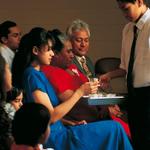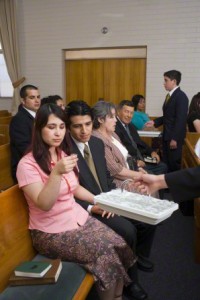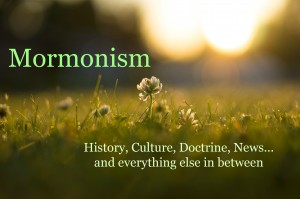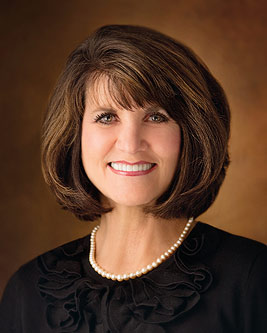This is the first in a series of articles exploring the priesthood as it is carried out by The Church of Jesus Christ of Latter-day Saints. Members of this church are often known as Mormons. The series will eventually explore the relationship between women and the priesthood, a hot topic in today’s media. Before we can begin to do that, however, we need a solid background in the priesthood itself. Only with this background can one begin to understand the role women play in the Church.
 Mormon priesthood is a bit different from priesthood as it is practiced in most other churches. It is given to every worthy male ages twelve and older, rather than to a small, select group of carefully educated members of the faith. They do not attend any special school or have a degree in religion. Their only training is the same training everyone, male and female, in the Church receives—attendance at regular church meetings and personal study. They are not paid for their duties, and this is important to remember.
Mormon priesthood is a bit different from priesthood as it is practiced in most other churches. It is given to every worthy male ages twelve and older, rather than to a small, select group of carefully educated members of the faith. They do not attend any special school or have a degree in religion. Their only training is the same training everyone, male and female, in the Church receives—attendance at regular church meetings and personal study. They are not paid for their duties, and this is important to remember.
Who Leads a Mormon Congregation?
When you visit a church service, you will see a congregational leader conducting the meeting. This will be the bishop or one of his two counselors. The bishop is a lay pastor and is not similar to a Catholic bishop. His counselors work with him to assist in the operation of the congregation. All three men will have other employment unless they are retired, and they will have families. Because of this, the priesthood is obviously not a full-time job, and the bishop does not carry out all the duties of a priest or minister in other faiths. Duties are distributed among all members of the congregation through callings, the Mormon term for a unpaid church position. Only a very small number of people have full-time positions in the ministry, and these people are also unpaid. Most serve for a limited time, and only the apostles and prophet, who head the entire church, are called for their lifetimes. They are unpaid, but a modest stipend is given to any who may need it. This stipend is not paid with tithing money. The Church operates a few for-profit businesses that provide income for anything that is not appropriately paid for through tithing.
 Given this structure, it is clear that a twelve-year-old boy is not going to have the authority a traditional priesthood holder would have in other religions. His duties are modest, but increase with age and experience. Boys do not run congregations, although they may help to lead their age-group quorum.
Given this structure, it is clear that a twelve-year-old boy is not going to have the authority a traditional priesthood holder would have in other religions. His duties are modest, but increase with age and experience. Boys do not run congregations, although they may help to lead their age-group quorum.
As mentioned earlier, all church members participate in the work of the Church. Tasks are divided in a variety of ways—age, gender, and geographic location being three of the most common. Mormons are not promoted through the ranks in their callings. There are several levels of priesthood, but priesthood is not a requirement for the majority of roles. A bishop may find himself serving in the toddler nursery the week after his five years as bishop come to an end—and he may consider it a more important position. People move between leadership and non-leadership roles regularly. The president of an organization may never have had a leadership position in her life, while her counselors may have decades of experience. Even the teachers serving under her may have more experience than she has. This is not considered important in the Church. Over a lifetime, a Mormon will serve in a wide range of roles, although most seem to end up somewhat specializing in one area or another, serving in one organization more often than the others. For instance, I am most often found teaching young children and joke that I am incapable of teaching without the help of puppets and flannel boards. However, I have also served in the auxiliaries for women and for teenagers, as well as in other positions throughout the church—as a missionary, a librarian, and a Sunday School teacher, for example.
What is the Mormon Priesthood?
For Mormons, the word priesthood has two meanings.
“First, priesthood is the power and authority of God. It has always existed and will continue to exist without end (see Alma 13:7–8; D&C 84:17–18). Through the priesthood, God created and governs the heavens and the earth. Through this power, He exalts His obedient children, bringing to pass “the immortality and eternal life of man” ( Moses 1:39; see also D&C 84:35–38).
Second, in mortality, priesthood is the power and authority that God gives to man to act in all things necessary for the salvation of God’s children. The blessings of the priesthood are available to all who receive the gospel (“Priesthood Authority,” Handbook 2, Administering the Church). (LDS.org Gospel Topics, Priesthood).
Power, authority, and blessings of the priesthood are important concepts in learning to understand how the priesthood operates in the lives of Mormons. While only men hold the priesthood, everyone in the Church receives the benefits of that priesthood. Men who hold the priesthood may not use it for frivolous or selfish things. They use it to serve others, making it one way—but not the only way—to serve God and His children.
Next week, we will explore the traditional roles of ministers in churches and how those duties are carried out in Mormonism.
About Terrie Lynn Bittner
The late Terrie Lynn Bittner—beloved wife, mother, grandmother, and friend—was the author of two homeschooling books and numerous articles, including several that appeared in Latter-day Saint magazines. She became a member of the Church at the age of 17 and began sharing her faith online in 1992.








“Second, in mortality, priesthood is the power and authority that God gives to man to act in all things necessary for the salvation of God’s children. The blessings of the priesthood are available to all who receive the gospel ”
I really appreciate this clear definition.
the fact that church services is almost completely unpaid is also unique and critical in understanding our church and how we relate with one another. It definitely changes things when one week they listen to you and the next, you listen to them.